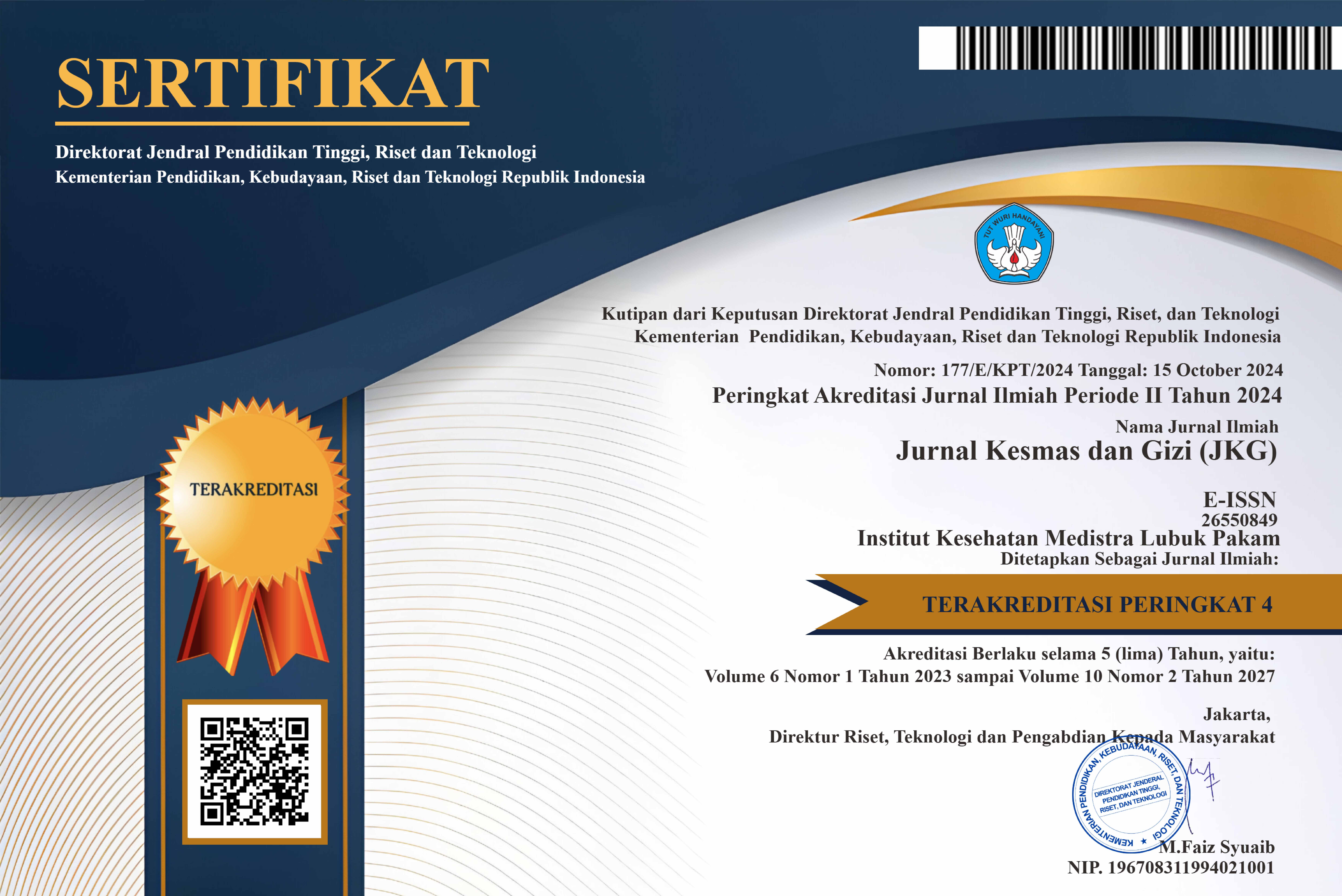THE CORRELATION BETWEEN THE HISTORY OF EXCLUSIVE BREASTFEEDING, MACRONUTRIENT INTAKE, AND ZINC INTAKE IN CHILDREN AGE 6-59 MONTH AT KEJAJAR 2 HEALTH CENTER WONOSOBO
DOI:
https://doi.org/10.35451/jkg.v6i1.1739Keywords:
Stunting, Breastfeeding, Macronutrient, ZincAbstract
Stunting is a global health problem that needs attention. Wonosobo Regency has one of the highest stunting rates in Central Java at 15.97% and Kejajar 2 Health Centre has the 4th highest stunting prevalence in Wonosobo at 23.88% in February 2023. The causes of stunting are maternal factors, breastfeeding, inadequate supplementary food, and a history of chronic infectious diseases. This study aims to determine the relationship between exclusive breastfeeding, macronutrient intake, and zinc intake in children 6-59 months at Puskesmas Kejajar 2. This study uses a type of quantitative research with an analytical observational design and a case control approach. The research instruments used were KMS (Kartu Menuju Sehat), SQ-FFQ (Semi Quantitative-Food Frequency Quesionare) questionnaire, and microtoise or infantometer. The sampling technique was quota sampling with a total of 172 respondents, with a ratio of case and control groups 1: 1. The data analysis performed was univariate analysis and bivariate analysis with the Chi Square test. The results showed that exclusive breastfeeding did not show a significant relationship with the incidence of stunting with a p-value of 0.321 or p>0.05 and there was a relationship between protein, fat, carbohydrate, and zinc intake with the incidence of stunting with a p-value of 0.000 or p<0.05. So it can be concluded that exclusive breastfeeding has no significant relationship with the incidence of stunting, while macronutrient intake and zinc have a significant relationship with the incidence of stunting at Puskesmas Kejajar 2 Wonosobo.
Downloads
References
Alves, F., P. Britto, S. Ferreira, L. Sawaya, & T. Florencio. (2014). Evolution of the Biochemical Profile of Children Treated or Undergoing Treatment for Moderate or Severe Stunting: Consequences of Metabolic Programming. J. Pediatr, 90, 356–362.
Aridiyah, F., N. Rohmawati, & M. Ririanty. (2018). Faktor-Faktor yang Mempengaruhi Kejadian Stunting pada Anak Balita di Wilayah Pedesaan dan Perkotaan. E-Journal Pustaka Kesehatan, 3.
Astuti, I. (2013). Determinan Pemberian ASI Eksklusif pada Ibu Menyusui. Jurnal Health Quality, 4 (1), 1–76.
Azmy U, M. L. (2018). Konsumsi Zat Gizi pada Balita Stunting dan Non-Stunting di Kabupaten Bangkalan. Amerta Nutrition, 2(3), 292–298.
Ballard. (2013). Human Milk Compotition?: Nutriens and Bioactive Factor. Pediatric Clinics of North America, 60 (1), 49–74.
Berawi, K. N. (2019). Decreasing Zinc Levels in Stunting Toddlers in Lampung Province, Indonesia. Biomedical and Pharmacology Journal, 12, 239–243.
Briliannita, A., Zaenab Ismail, & La Supu. (2022). Faktor Resiko Kejadian Stunting pada Anak 6-7 Tahun. Jurnal Ilmiah Kesehatan, 4 (1), 90–97.
Canfora, E. E., J.W. Jocken, & E.E. Blaak. (2015). Short-chain Fatty Acids in Control of Body Weight and Insulin Sensitivity. Nat. Rev. Endocrinol, 11, 577–591.
De Onis M., & Branca F. (2016). Childhood Stunting: A Global Perspective. Matern Child Nutr., 1(1), 12– 26.
Dinas Kesehatan Kabupaten Wonosobo. (2022). Pencatatan dan Pelaporan Gizi Berbasis Masyarakat. Wonosobo?: Dinas Kesehatan Kabupaten Wonosobo.
Dinas Kesehatan Kabupaten Wonosobo. (2023). Pencatatan dan Pelaporan Gizi Berbasis Masyarakat. Dinas Kesehatan Kabupaten Wonosobo.
Kementerian Kesehatan RI. (2019). Profil Kesehatan Indonesia 2018. Jakarta?: Kementerian Kesehatan RI.
Kementerian Kesehatan RI. (2022). Hasil Survey Status Gizi Indonesia (SSGI) 2022. Jakarta?: Kementerian Kesehatan RI.
Latifah, A. M., Purwanti, L. E., & Sukamto, F. I. (2020). Hubungan Pemberian ASI Eksklusif dengan Kejadian Stunting pada Balita 1-5 Tahun. Health Sciences Journal, 4 (1), 131–142.
Manggabarani, S., Rani Rahmasari Tanuwijaya, & Irfan Said. (2021). Kekurangan Energi Kronik, Pengetahuan, Asupan Makan dengan Stunting?: Cross Sectional Study. Journal of Nursing and Health Science, 1 (1), 1–7.
Maria, N., & Afriyanti, O. (2018). Hubungan Berat Badan, ASI Eksklusif, MP-ASI, dan Asupan Energi dengan Stunting pada Balita Usia 24-59 Bulan di Puskesmas Lubuk Buaya. Jurnal Kesehatan Perintis, 5 (1), 39–45.
Nuraini, I. S., Muhammad Sulchan, & Fillah Fithra Dieny. (2017). Resistensi Insulin pada Remaja Stunted Obesity Usia 15-18 Tahun di Kota Semarang. Journal of Nutrition Collage, 6 (2), 164–171.
Nurdiana, N. (2015). Factors Affecting the Level of Hemoglobin on Junior High School Children on Coast Regional District of North Lombok. Biota, 8(1), 1–18. https://doi.org/10.20414/jb.v8i1.54
Nurmalasari, Y., Tessa Sjariani, & Putra Intan Sanjaya. (2019). Hubungan Tingkat Kecukupan Protein dengan Kejadian Stunting pada Balita Usia 6-59 Bulan di Desa Mataram Ilir Kec. Seputih Surabaya Kabupaten Lampung Tengah Tahun 2019. Jurnal Ilmu Kedokteran Dan Kesehatan, 6 (2), 92–97.
Oktarina, Z., & Trini Sudiarti. (2013). Faktor Resiko Stunting pada Balita (24-59 Bulan) di Sumatera. Jurnal Gizi Dan Pangan, 8 (3), 175–180.
Permenkes. (2020). Peraturan Menteri Kesehatan Republik Indonesia Nomor 2 Tahun 2020 Tentang Standar Antropometri Anak. Kementerian Kesehatan Republik Indonesia.
Siringoringo, E. T., Ahmad Syauqy, Binar Panungga, Rachma Purwanti, & Nurmasari Widyastuti. (2020). Karakteristik Keluarga dan Tingkat Kecukupan Asupan Zat Gizi Sebagai Faktor Risiko Kejadian Stunting pada Baduta. Journal of Nutrition College, 9(1), 54–62.
Tampubolon, D. (2020). Kebijakan Intervensi Penanganan Stunting Terintegrasi. Jurnal Kebijakan Publik, 11 (1), 1–58.
Umami, W., & Ani Margawati. (2018). Faktor-faktor yang Mempengaruhi Pemberian ASI Eksklusif. Jurnal Kedokteran Diponegoro, 7 (4), 1720–1730.
Verawati, B., Nur Afrinis, & Nopri Yanto. (2021). Hubungan Asupan Protein dan Ketahanan Pangan dengan Kejadian Stunting pada Balita di Masa Pandemi Covid-19. Jurnal Kesehatan Masyarakat, 5 (1), 415–423.
Waliyo, E., S.F. Agusanty, & D. Hariyadi. (2020). Local Food-based Prebiotic Formula Can Increase LFA Z-score in Children Stunting. AcTion Aceh Nutr, 5, 130–139.
WHO. (2013). Childhood Stunting?: Challange and Oportunities. Geneva?: World Heath Organization.
Windasari, D. P., Ilham Syam, & Lilis Sarifa Kamal. (2020). Faktor Hubungan dengan Kejadian Stunting di Puskesmas Tamalate Kota Makasar. Aceh Nutrition Journal, 5 (1), 27–34.
Wirjatmadi, B. D. (2012). Beberapa Faktor yang Berhubungan dengan Status Gizi Balita Stunting. The Indonesian Journal of Public Health, 8 (3), 99–104.
Downloads
Published
Issue
Section
License
Copyright (c) 2023 Noviasari, Natalia Desy Putriningtyas

This work is licensed under a Creative Commons Attribution 4.0 International License.
Copyright in each article is the property of the Author.


























